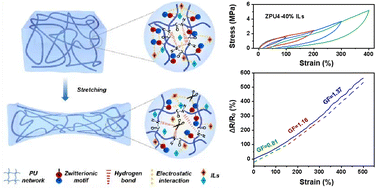Skin-mimetic tough polyurethane ionogel for use in soft ionotronics†
Abstract
An artificial skin that simulates not only the mechanical performance but also the conductive behavior of natural skin is highly desired in the fields of wearable sensors and human–computer interaction. However, there is usually a trade-off between mechanical toughness and ionic conductivity. Herein, a transparent zwitterionic polyurethane (ZPU) ionogel with excellent mechanical toughness and ion conductivity is developed by casting and drying an unevenly dispersed ILs-PU emulsion. The zwitterionic diol extender is adopted with a normal diol, which is expected to promote the free ion and form electrostatic aggregations for energy dissipation. The obtained gel possesses high stretchability (1075%), tensile toughness (84.2 MJ m−3), and tearing energy (18.9 kJ m−2) with considerable resilience, and is sensitive to the applied strain and could be used to detect general human motion. The developed ZPU gel is coated on the surface of an elastic and porous commercial sponge to prepare a pressure sensor, which exhibits fast and accurate sensitivity towards the external pressure. We believe the ZPU molecule developed here will promote the development of a tough ionogel and its applications in I-skins and soft electronics.

- This article is part of the themed collection: 2023 Journal of Materials Chemistry C HOT Papers


 Please wait while we load your content...
Please wait while we load your content...